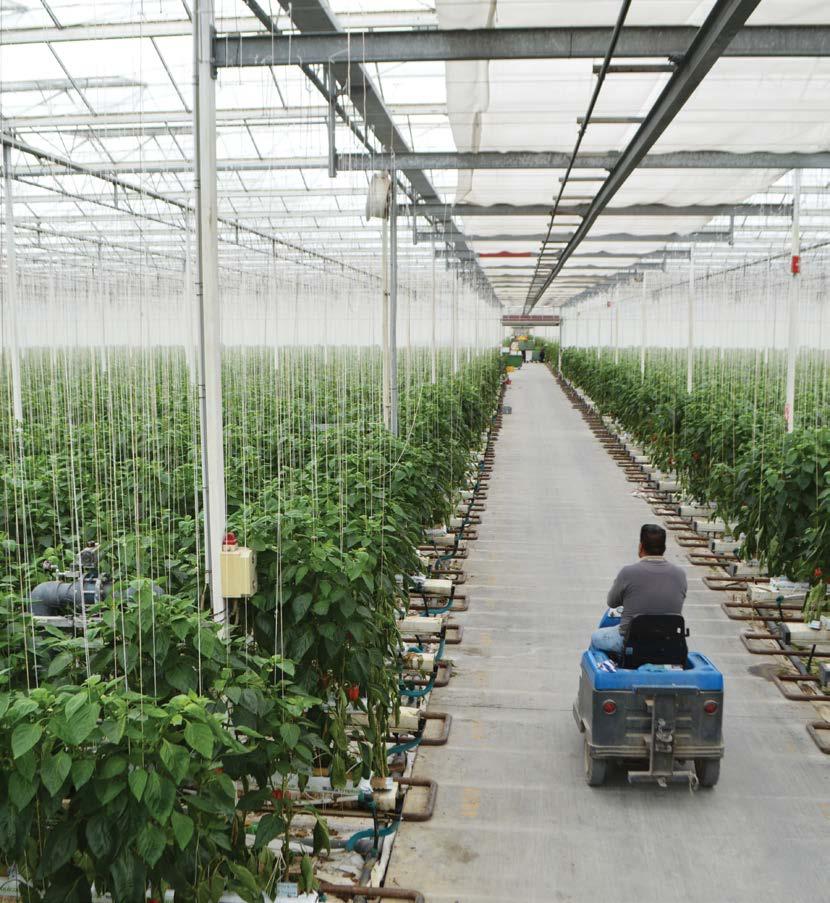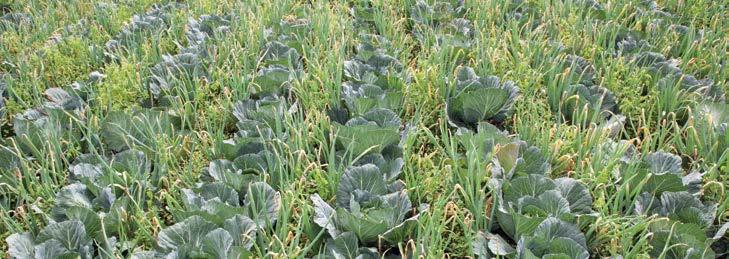
9 minute read
Next-gen robotic asparagus harvester under trial
TECHNICAL
THE LATEST INNOVATIONS AND IMPROVEMENTS
20 GROWING WITH GAS
NEW CONTROLS COME
INTO FORCE FOR THE HERBICIDE PARAQUAT IN DECEMBER
Words by Rebecca Fisher : Crop Protection Manager, Market Access Solutionz horticulture only (i.e. not forestry or ornamental horticulture in
This article reminds growers that use the herbicide paraquat that new controls come into force next month.
These new controls are as a result of the New Zealand EPA (Environmental Protection Authority) reassessing manufacturers have an extra year after this to change the December 2021 when these controls must be followed but
paraquat last year.
FROM 11 DECEMBER 2020:
Paraquat must only be applied at a maximum rate of 600g of paraquat per hectare per calendar year. This can be in one or several applications, such as 200g of paraquat per hectare applied three times in a year, but the total amount applied in any year must not exceed 600g.
The controls take effect from 11
Group manager. website: https://www.epa.govt.nz/public-consultations/
Only coarse or larger droplet sizes can be used.
The following buffer zones must be followed:
APPLICATION METHOD
Ground Aerial
MAX RATE G AI/HA * <400 400 – 600
0 metres 5 metres 5 metres 15 metres
(*grams of active ingredient per hectare)
No buffer zone applies to ground-based application if it is Unlike some reassessments, the EPA has not restricted which crops paraquat is allowed to be used on (i.e. it can still be used off label as long as all the above controls are adhered to). There is a restriction limiting the use of paraquat to publicly accessible places such as public gardens). The controls take effect from 11 December 2020, but product label. This means that there will be a period until they may not be reflected on the product label. Growers therefore must be aware of this.

If you would like further clarification or guidance on these changing controls, please contact your Product
The EPA’s decision on paraquat can be found on its done using non-motorised hand-held equipment.
decided/reassessment-of-paraquat/
MICRONUTRIENTS AND
SOIL CONTAMINANTS
By Robin Boom : CPAg, Member of the Institute of Professional Soil Scientists
Plants need at least 16 elements to grow and these can be categorised into major elements and micronutrients.
The major elements are carbon, oxygen, hydrogen, nitrogen, phosphorus and potassium). Most of the carbon, hydrogen and oxygen comes from the air, and nitrogen, are also other major elements – sulphur, calcium and magnesium – which plants need to grow. Then there are the essential trace elements or micronutrients – boron, iron, manganese, copper, zinc, and molybdenum. Iron, manganese and copper are all involved in various processes related to photosynthesis. Iron, copper, manganese and zinc are involved with various enzyme systems in plants. Zinc in particular is needed for the production of auxins which are plant growth hormones affecting leaf and shoot elongation. Boron is the only micronutrient not involved with photosynthesis and enzyme function, but is critical for the production of sugars and other carbohydrates in plants as well as the reproduction system. Molybdenum is mainly needed for enzymatic nitrogen assimilation in plants.
5.8 – 6.3
THE SWEET SPOT FOR PH FOR MOST PLANTS FOR PHOSPHORUS AND TRACE ELEMENT AVAILABILITY SITS IN THE 5.8 TO 6.3 RANGE
There are many soil related complexes which determine the availability of elements, and because a soil test may show adequate levels of a particular element does not necessarily mean that the plant will be able to adequately absorb it. Soil pH (acidity/alkalinity) for example has a bearing on the availability of many elements, with molybdenum becoming more available as the pH lifts, whereas the metallic elements iron, manganese, copper, zinc, and also boron become less available for plant uptake as the pH rises. Phosphorus uptake is also affected by the soil pH as it is not as readily bound up by iron and aluminium complexes as the pH lifts, but having too high pH can cause it to be bound up by excessive calcium. This is why the sweet spot for pH for most plants for phosphorus and trace element availability sits in the 5.8 to 6.3 range. A higher pH also favours soil microbial activity and earthworm numbers and better facilitates nitrogen fixation by leguminous plants and other nutrient cycling
phosphorus and potassium come from the soil. There in the root zone. There are also other factors affecting the availability of micronutrients such as the organic matter content and excesses of competing elements. Under intensive horticulture it is common to find excessive amounts of phosphorus and potassium build-up in the soil which can impact on the availability of micronutrients. High phosphorus for instance can impede the uptake of iron, copper and zinc, while excess potassium can impact on the availability of copper, calcium and magnesium. Excess nitrogen can reduce the availability of calcium, magnesium, copper and boron and can also affect the storage ability of many fruit and vegetables because of excessive nitrate levels. Excess nitrogen and phosphorus are also recognised environmental contaminants, and it makes little sense over-fertilising crops for economic, environmental and productive reasons. Mounting pressure to clean up the environment by reducing unnecessary inputs can improve crop yields when these are being affected by micronutrient deficiencies, and it can improve crop quality. There are also some fertiliser contaminants, namely fluoride and cadmium, which have built up on high fertility areas. All sources of naturally occurring phosphate rock contain fluoride, and in the manufacture of superphosphates much of this fluoride remains. On pastoral farms, what is commonly referred to as phosphate poisoning where animals die after ingesting fertiliser from recently fertilised pastures, is actually fluoride poisoning caused by fluorosis of the liver. There is also some overseas research showing phytotoxicity in plants to excess fluoride build-up in the soil. Imported high analysis fertilisers and compound fertilisers tend to have a lot lower fluoride levels than locally manufactured superphosphate. The other noted contaminant in phosphatic fertilisers is cadmium, which is a heavy metal that builds up in the soil. Properties which received high amounts of Nauru or Christmas Island superphosphate before the 1990s may have high cadmium levels. The fertiliser industry has now set its own standard of not selling fertilisers which contain over 280 ppm of cadmium per kilogram of phosphorus.
Most high analysis and compound fertilisers contain low levels of cadmium. Being a heavy metal, cadmium tends to accumulate in certain body organs such as the liver, kidneys and brain. Most of our soils have below 0.5 ppm of cadmium naturally, but if levels have climbed above 1 ppm, fertilisers containing cadmium should be avoided so it does not get into the human food chain. Currently the liver and kidneys from older cattle and sheep in New Zealand are no longer sold for human consumption because of the risk of high cadmium levels. For horticultural crops, discontinuing indiscriminate fertilising with phosphatic fertilisers when soil phosphorus levels are already high will help circumvent any potential barrier to selling produce to the general public and for overseas export due to potential cadmium concerns. Two other heavy metal contaminants which are also micronutrients are zinc and copper, which both have fungicidal properties. When I was consulting in the United Kingdom 20 years ago I tested some hop growing ground and was surprised to see extremely high copper levels in the soil from decades of copper oxychloride and other copper containing fungicides. Excessive copper can have a detrimental affect on the availability of other elements such as iron, zinc, manganese and phosphorus, as well as affecting soil microbial communities and earthworms. In recent years I have noted a big spike in soil copper levels on some kiwifruit orchards from the use of copper sprays to counter Psa and should this continue it may become cause for concern. Some long established fruit tree orchards which have been sprayed for decades with copper sprays have excessively high copper levels. Zinc levels can be high in some pig manure and biosolid materials, and the continued use of zinc oxides and sulphates given to animals in the North Island to help mitigate against the effects of facial eczema over the past forty years has raised zinc levels on some farms several times higher than the natural background zinc levels. All of these heavy metals become less available when the soil pH is kept up, and when there are good phosphorus and organic matter levels, the plant availability of these elements is reduced. It all comes down to having the correct balance of nutrients in the soil, a kind of Goldilocks zone where there is not too much nor too little, but the levels are just right – agronomically, environmentally and financially.
Access locked up phosphate in your soil
Blotta® is a unique ground-breaking soil complexing agent which works when localised in the soil to prevent both lock-up and to release phosphate and other essential nutrients for uptake by the roots of crop plants.
Why does Roger Blyth (Senior Agronomist, Seed & Field Services Ltd) see the importance of applying Blotta®?
This product represents a great opportunity to help us increase the efficiency of crop nutrition, especially in relation to phosphorous. By localising the application of Blotta®, we can protect both applied P and use the strength of Blotta® to release P that has been complexed with aluminium, which is prevalent in our New Zealand soils. We have seen Blotta® increase the measured available P by at least double in the lab. This was done on the same Canterbury soil sample, which was taken and then split into two, one being treated with Blotta® and one untreated. This demonstrates, even in the absence of applying fertiliser, Blotta® has the capacity to outcompete certain antagonistic elements in the soil, which render phosphorous unavailable and then release it for crop nutrition.

We have found it very user friendly and I consider it to be a tool we will continue to use, as a method by which we can increase the efficiency of, primarily, applied P and to begin to find a way to reduce inputs without detriment to yield.

Seed & Field Services Ltd
is available NZ wide exclusively through Seed & Field Services (South Island).
Contact us today to find out more. Phone: 03 302 7317 | enquiries@sfssil.co.nz










